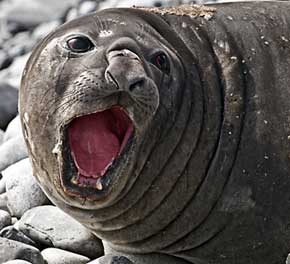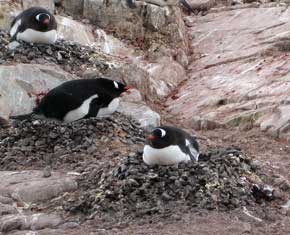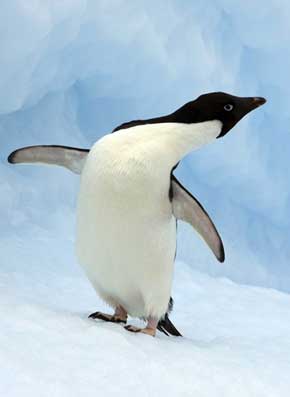Making Landfall
We would take two and sometimes three excursions a day in a Zodiac, an inflatable boat about 5.5 m (18 ft) in length. On these trips we would cruise around icebergs and land on the continent. There are two ways for cruise passengers to reach land in Antarctica. The Zodiac can bring the passengers to a small wooden dock for a dry landing. However, in Antarctica, most landings are wet landings. The Zodiac approaches the shore at a predetermined point but stops short of land. With the boat idling, the passengers climb over the side of the Zodiac and literally wade to shore through the frigid water. Of course, one has to be wearing knee-high waterproof boots to do this.
|
We got close, but not too close, to the elephant seals on Jenny Island.
Gentoo and chinstrap penguins nest on the rocky shores. |
|
An Adelie penguin greeted us when we disembarked on pack ice during a night landing. |
Strict rules and regulations have been created to protect the ecology of the Antarctic environment from visitors. There are restricted zones for maintaining a safe distance from the wildlife. No feeding or touching of the animals is allowed. There is rigid control of waste disposal.
Despite the severe weather, Antarctica has rich animal life amazingly well adapted to the harsh conditions. While on land, we let the wildlife come to us. Watching animals in their natural environment can result in some amazing pictures and personal thrills. When you see nature up close, where the human impact is minimal, it is truly humbling. I was able to photograph the three species of the brush-tail penguins nesting on their baby chicks. We walked among sleeping Weddell and elephant seals.
Among the passengers on our trip were two researchers from Oceanites, a nonprofit group studying penguins in peril. The Oceanites researchers spent the day studying penguins. They joined us in the dining room for all meals, and usually after dinner they spoke of the research they had done that day. Often they showed slides of their work from that day. As with all the National Geographic guides, the Oceanites researchers served as guides or teachers, and they would tell us what to look for during the next day’s outing.
We learned that Adelie penguins in Antarctica are in the midst of a major upheaval. Global warming is causing their icy habitat to warm up, and the Adelie population is in rapid decline. These penguins rely on winter sea ice as a platform for feeding on ocean krill. They also need the ice to shrink in the summer so they can reach their breeding colonies on land. The Antarctic Peninsula once provided the perfect habitat for the Adelie penguins, but because of the warming climate, this is no longer true. If the temperature continues to increase, Adelie penguins will be locally extinct in five to ten years. However, scientists are finding that with the warmer temperatures in Antarctica, some populations of penguins are thriving. The chinstrap and gentoo penguins are moving into the warming Antarctic habitats once occupied by the Adelies!
Antarctica touches everybody who goes there in different ways. For me it was like being a child again, recapturing at the age of 61 that precious sense of wonder that a child takes for granted. It was even better than that, because at 61 I know just how rare and fleeting such a sense of wonder is, and how extremely fortunate I was to have the opportunity to see such an amazing place.
The Antarctic continent functions as one of the Earth’s “refrigerators,” regulating the ocean currents and the world’s climate. Any significant environmental change there would alter the global patterns of weather, with disastrous consequences. It was a great privilege to go to Antarctica. I feel a great sense of responsibility to get the word out to people everywhere: We need to protect Antarctica. Extinction is forever and climate change is real.
This content has been re-published with permission from SEED. Copyright © 2025 Schlumberger Excellence in Education Development (SEED), Inc.



